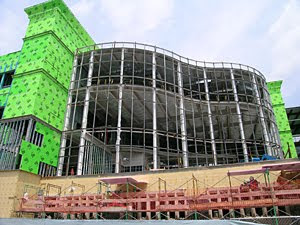A Critical Link: New Medical School Creates Stronger Bond between Roanoke and Blacksburg
Posted by Lee Crawford at 9/01/2009 03:04:00 PMOne day in July, Ed Murphy got some good news. Locomotives that had been rusting in a Roanoke scrap yard for decades were going to be hauled away to railroad museums. Another piece of the city’s railroad history was making way for a new economic engine, a medical school and research institute involving Blacksburg-based Virginia Tech and Roanoke-based Carilion Clinic, the health system that Murphy heads.
Some locals believe the ventures may become bigger than the railroad — a bold statement considering that Roanoke might still be a small town called Big Lick if the Norfolk & Western Railway hadn’t set up shop there in the 1880s. Murphy, though, is having none of this “bigger than the railroad” talk. “I’m not sure what that means,” he says. “It sounds weighty.”
Still, he adds, “There’s no doubt that an important component of the economic development of this community and the economic future of this region revolves around health care, education, research and the interconnection of all those parts.”
That interconnection is tying the economic fortunes of Roanoke and Blacksburg closer together, business leaders say. The lines between the two are “more governmental than they are practical,” says Beth Doughty, executive director of the Roanoke Valley Economic Development Partnership.
People coming into the area are increasingly thinking of the Roanoke and New River valleys as one place, not two, says Murphy. “I personally think there is a lot of value to defining this region as including both valleys because I think that they have important complimentary assets. So the more we can contribute to that being a reality, the better, I think, that we’re doing for the region.”
While collaborating with Tech on the medical school, Carilion also is transforming itself into a clinic employing a variety of specialists. It has hired 200 physicians in the past three years. There have been a few bumps along the way, including a challenge from the Federal Trade Commission regarding recent Carilion acquisitions. The complaint says the $20 million purchase of the Center for Advanced Imaging and the Center for Surgical Excellence, two Roanoke-area outpatient facilities, eliminated competition and will lead to higher health-care costs.
There have been a few bumps along the way, including a challenge from the Federal Trade Commission regarding recent Carilion acquisitions. The complaint says the $20 million purchase of the Center for Advanced Imaging and the Center for Surgical Excellence, two Roanoke-area outpatient facilities, eliminated competition and will lead to higher health-care costs.
“The FTC inquiry will not affect the development of the medical school, or Carilion’s ongoing development as a physician-led clinic,” says Carilion spokesman Eric Earnhart. “We are concerned that the complaint appears to be based on inaccurate information.”
The Virginia Tech Carilion School of Medicine is on track to welcome its first class of 42 students in August 2010. In June, the school received preliminary accreditation for its doctorate of medicine program from the Liaison Committee on Medical Education.
Carilion and Tech, in fact, have been partners for a long time, collaborating on research for about a decade. Now Carilion and Tech are reclaiming a former rail yard, turning a site that held a cement plant, a flour mill and the scrap yard with old locomotives into Riverside Center, a 30-acre biomedical park.
Riverside Center is coming to fruition at a time when unemployment in the Roanoke and Blacksburg areas is climbing. In June, Roanoke’s jobless rate was 7.8 percent and Blacksburg’s was 9.5, both higher than the state average of 7.3 percent.
Murphy believes that the emerging biomedical campus will attract research teams and other professionals with average annual salaries of $100,000 and more. Just putting up the buildings to accommodate the medical school has pumped more than $200 million into the local economy, he says.
Brian Townsend, Roanoke’s assistant city manager for community development, says real estate taxes alone will add $2 million a year to city coffers.
The people who will populate Riverside Center have started to arrive. There have been only 18 new hires so far, but Carilion projects 251 more jobs will be filled when the medical school and research institute are going full force.
Douglas Waters, interim president of Downtown Roanoke, Inc., says activity generated by Carilion and the medical school have helped to fuel the growth of downtown living in Roanoke.  Waters lives in a converted bank building. Other downtown buildings, including former railroad office headquarters, have been reborn as upscale condominiums.
Waters lives in a converted bank building. Other downtown buildings, including former railroad office headquarters, have been reborn as upscale condominiums.
Murphy, though, says it’s wrong to focus on the Carilion-Tech collaborations to the exclusion of everything else being done to spark the area’s economy. He mentions the greenways being built throughout the valley, the planned renovations to the City Market Building, proposed renovations to Center in the Square, which houses a science museum and a history museum, and the development of the Roanoke River as “an urban amenity.”
Doughty, the Roanoke Valley Economic Development Partnership executive, says the changes reflect a new perspective on economic development. “The old model was you just attracted jobs and that was how you grew your population,” says Doughty. “The new model is you build a place that people want to be and that attracts the talent and the jobs follow the talent.”
She cites the examples of place such as Asheville, N.C.; Bend, Ore.; and Boulder, Colo. “I would definitely say that we tried to be Charlotte for too long,” she says.
Visit Virginia Business here.



